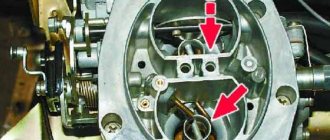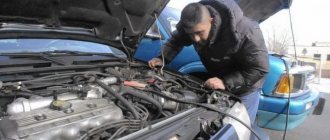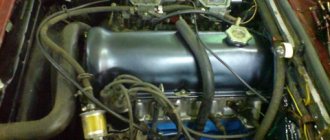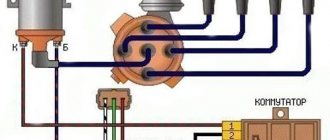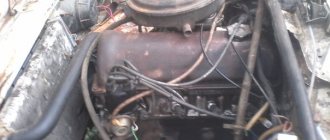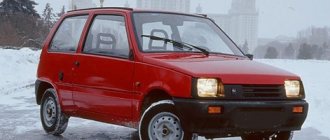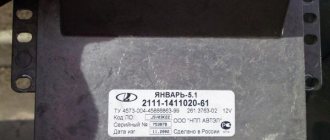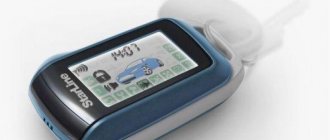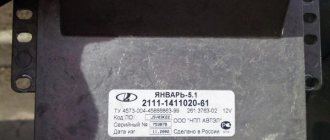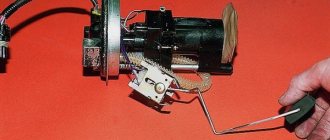Incorrect engine start of VAZ 2109
Before drawing any conclusions, it is necessary to ensure that the driver correctly follows the requirements for starting a cold engine. For these purposes, carburetor engines have a manual throttle control drive. Without using this mechanism, starting the car, especially in cold weather, is quite problematic.
You need to start the engine in the following sequence:
- Open the hood and pump up fuel using the manual fuel pump pedal
- Pull the choke control handle towards you
- Pump gasoline into the manifold using the accelerator pedal
- Without pressing the gas pedal, start the engine
You may not be able to start the engine the first time. But the second time it should. You also need to pay attention to pumping gasoline with the gas pedal. The main thing here is not to overdo it, otherwise you can fill the spark plugs and then the engine will definitely not start. If this does happen and the car does not start, then press the pedal all the way, turn on the starter and, while it rotates, slowly release the gas pedal.
Diagnosis of sensor failure
Let's consider deviations in engine operation and the corresponding possible causes. Unstable operation at idle, difficult starting or stopping the engine after driving in high power mode can be caused by malfunctions of the mass air flow sensor (MAF) - it will give the controller at low speeds readings that are 15–25% higher. If there is excessive fuel consumption or the engine response has decreased, the mass air flow sensor gives underestimated readings.
Jerks and dips when switching from idle to operating speeds, even in the case of light loads, means that the operation of the sensor that reads the throttle position has been disrupted. Difficulty starting a warm engine or slight excess fuel consumption - the coolant temperature sensor has failed.
The starter turns poorly on a cold VAZ 2109
This is one of the most common causes of poor fret starting. There are two sides to this: the starter is stuck or the battery is frozen. If everything is clear with the first case, then the second requires special attention.
In severe frosts, it is recommended to bring the battery into the house and charge it, then starting problems will be left behind. But if this is not done, the task may become more difficult. To start, you will need to turn on the low beam for a while - this will warm up the electrolyte. After this, you can try to turn on the starter for no more than 3 seconds. Each new attempt to start the engine must be accompanied by pauses of 30 seconds, 1 minute and 2 minutes. Otherwise, the battery will run out completely and instead of traveling you will have to wait until the battery is charged.
If the carburetor starts to stall at idle
This situation often occurs in carburetor VAZ-2109 cars. You can do the following with your own hands:
- needle replacement;
- cleaning the jets in the solenoid valve;
- replacing the idle speed sensor if a fault is detected in it;
- Sometimes the needle valve gets stuck. There is a popular effective method. If the carburetor does not want to start when hot, a spring is put on the valve;
- The solenoid valve control unit and wiring are checked. And then the car will start.
If you turn to an experienced carburetor for advice, he, based on his practice, will definitely tell you that by carefully inspecting the car’s components and replacing worn and damaged carburetor elements, their previous functionality will return. And then the car will start without problems - whether hot or cold.
There is a special offer on our website. You can get a free consultation with our corporate lawyer by simply submitting your question in the form below.
Source
Thickened oil
If in summer you can fill in oil with a lower viscosity or 20w40, then in severe frosts it freezes. It becomes very difficult to turn the crankshaft with frozen oil, so the manufacturer recommends using motor oils with a viscosity of 5w40 for the winter.
Another solution to this problem is the use of pre-heaters, which are connected to a 220 V network and heat up the antifreeze. Due to the heat transfer of the metal parts of the VAZ 2109 carburetor engine, the oil becomes thinner, and the engine can operate safely even in severe frosts.
If the carburetor starts to stall at idle
This situation often occurs in carburetor VAZ-2109 cars. You can do the following with your own hands:
- needle replacement;
- cleaning the jets in the solenoid valve;
- replacing the idle speed sensor if a fault is detected in it;
- Sometimes the needle valve gets stuck. There is a popular effective method. If the carburetor does not want to start when hot, a spring is put on the valve;
- The solenoid valve control unit and wiring are checked. And then the car will start.
If you turn to an experienced carburetor for advice, he, based on his practice, will definitely tell you that by carefully inspecting the car’s components and replacing worn and damaged carburetor elements, their previous functionality will return. And then the car will start without problems - whether hot or cold.
There is a special offer on our website. You can get a free consultation with our corporate lawyer by simply submitting your question in the form below.
Incorrect ignition timing
If the VAZ 2109 starts poorly not only when cold, but also when hot, then the problem may affect the ignition system. An incorrect advance angle impairs starting properties, making starting difficult.
Typically, starting problems occur with late ignition. In this case, you can notice black smoke from the exhaust pipe, the electrodes of the spark plugs become covered with black soot, and popping noises are heard in the muffler when you press the accelerator pedal. You can try turning the distributor a few degrees or adjusting the ignition from scratch. The problem should go away.
However, an angle that is too early results in:
- Detonation;
- Engine overheating;
- Leaning the mixture.
Carburetor car engine starts and stalls
Symptoms of a problem
There is no fuel in the float chamber
Pump it up using the manual pump lever on the fuel pump.
The fuel pump or power system may be faulty. Remove the hose from the carburetor fuel supply fitting and press the manual primer lever on the fuel pump several times. A strong pulsating stream of gasoline should come out of the hose hole. If it is missing or weak, check the fuel pump or power system.
The strainer at the carburetor inlet is clogged
Remove it by unscrewing the cap, clean it (you can use a toothbrush), rinse with acetone or gasoline and blow with compressed air. At the same time, clean the filter seat in the carburetor cover.
The solenoid valve is faulty or the fuel jet of the idle system is clogged
Check whether the solenoid valve or the idle air system fuel nozzle holder has become loose due to any circumstances. Turn it on. Remove the wire from the valve and then put it back on. You should hear the click of the valve being activated. If it is not there, we connect a piece of wire plus the battery and the valve outlet. There is no click - we change the valve. There is a click - we check the EPH system.
Check the serviceability of the valve itself by unscrewing it from the carburetor and removing the fuel jet from it. The jet should be carefully inspected for contamination and deformation. We also check the ease of movement of the valve shut-off needle, the presence and integrity of the rubber O-ring on the valve body.
Unscrew the idle air system fuel nozzle holder (on carburetors with a holder instead of a solenoid valve), rinse, clean the fuel nozzle and blow with compressed air.
“Suction” of foreign air into the carburetor
In this case, the fuel mixture is lean. If the engine starts and immediately stalls, it is most likely very lean. The image shows probable places where foreign air is “sucked in” on the 2108 Solex carburetor.
Read more about the “suction” of foreign air in the article “Suction of foreign air into the carburetor.”
Disassemble the starter housing and replace the diaphragm with a new one. Adjust the starting device.
It is necessary to remove the carburetor cover, unscrew the jets, remove the tubes, rinse and clean them, clean the wells, blow everything out with compressed air and put it back. The image shows what should be cleaned on the carburetor 2105, 2107 Ozone.
On the Solex carburetor, unscrew the air jets and take them out along with the emulsion tubes. At the bottom of the opened wells there are fuel jets. We turn them out with a thin long slotted screwdriver. Clean, rinse with acetone and blow with compressed air.
Fuel and air jets and idle system channels are clogged
Unscrew the jets, rinse and clean them, and blow them with compressed air.
You can try to clean the idle system without disassembling the carburetor. Here is an article on this topic “Cleaning the idle system of the carburetor 2108, 21081, 21083 Solex.”
The fuel level in the carburetor float chamber is broken
The fuel mixture is either very lean or very rich due to incorrect adjustment.
Articles on the site about adjusting the fuel level:
The carburetor air damper drive is not adjusted (“choke”)
A not fully open air damper causes the fuel mixture to become richer in some cases to such an extent that it is difficult to start the engine, especially when it is hot. The spark plugs may become flooded with fuel. Adjust the drive:
With the choke handle fully extended, the air damper should completely cover the cross-section of the first chamber of the carburetor.
With the handle fully recessed, the air damper should be strictly vertical.
Notes and additions
— Before searching for the reasons that a carburetor engine starts and stalls, it is recommended to check the serviceability of the ignition system, since the symptoms of its malfunction are similar to the symptoms of a malfunction of the ignition system and the presence of fuel supply through the power system.
TWOKARBURATORS VK -More information on this topic in our VKontakte group TWOKARBURATORS DZ -and in Yandex Zen
Source
Problems of the VAZ engine power supply system
First of all, you need to check the air and fuel filters. If they are heavily contaminated, the engine will have difficulty starting when cold. The design of the nine provides two fuel filters located under the hood and the car and one air filter. If they are intact, then check the operation of the fuel pump.
Try pumping gasoline manually. If it pumps poorly, then the fault lies in the fuel pump.
Next in line is the carburetor. Incorrect adjustment can lead to the car being difficult to start when cold. Idle speed should not exceed 900 and fall below 700. Soot on the spark plugs is unacceptable. Otherwise, the unit needs proper configuration.
DTOZh replacement procedure and timing
The procedure for replacing the DTOZh may differ depending on the car model. At the VAZ, to carry out the process, you need to prepare several tools, including the obligatory set of wrenches.
According to the classic scenario, the coolant will have to be drained, otherwise replacing the DTOZH cannot be called correct. Although there are several replacement options that do not involve draining.
As mentioned above, one of the DTOZH is located in the thermostat. It screws in from the side. The second is located a little lower, wrapped in the cylinder head.
A little about the timing of replacement of DTOZH. If we are talking about a regulator that goes to the pointer, then it must be replaced at the very moment when the temperature values go astray. This is easy to check: for example, when the engine is cold, the coolant needle tends to the red zone or simply wanders. This is an error and requires correction, i.e., replacement of the sensor.
In some cases, it also happens that it is not the regulator itself that is to blame, but the wiring or contact. You need to check everything, and only then decide whether to change it or not. Testing the wiring is also easy: the wires are disconnected from the DTOZH, the ignition is turned on and a short to ground is made. If the arrow jumps up, then everything is in order with the wiring.
The second DTOZH changes if the machine itself is not working properly. For example, the speed of a cold engine does not increase, but when it is hot it reaches a value of 1500 rpm. Fault number 2 can also be judged by the cooling fan, which turns on too early or does not do so at all.
Temperature controllers that have been removed are easiest to check. They must be immersed in boiled water heated to certain values, then connect an ohmmeter to measure the resistance coming from the DTOZH.
- Absolutely legal (Article 12.2);
- Hides from photo and video recording;
- Suitable for all cars;
- Works through the cigarette lighter connector;
- Does not cause interference to radios and cell phones.
Malfunction of explosive wires
We check the wires, as they can also cause malfunctions. If the inside of the distributor cover is chipped and the contacts are scorched, then it needs to be replaced. After removing the slider, having first checked that the drum does not touch the Hall sensor, unscrew the bolts and disconnect the wiring and replace the sensor.
The wires on the distributor cover go in the following order (incorrect order of connecting the wires can also cause the car to not start):
- The first (it is marked on the cover) comes from the far left and also the first cylinder.
- Further, if you look clockwise, the second cylinder follows, and behind it the 4th.
- The far right wire comes from the third cylinder.
Under the casing there is a rubber timing belt. If the teeth (one of them) are worn down, and even more so if there is a tear on the belt itself, then replacement is needed.
If you still have questions about why your 9 won’t start, I recommend watching this video:
Serious damage
And here it’s worth starting with a broken timing belt. The motor spins, but very easily, since the valves are all open. Check the belt right away to see if it is in place. Moreover, sometimes it happens that the front part is intact, but the back part, which runs along the roller and pump, is torn. Remove protection and check integrity. Of course, you can’t do without replacing the belt, so there should always be one in stock, at least a little “alive”.
If the engine does not start, but the starter spins quickly without engaging the flywheel crown, then we can conclude that the teeth have worn out. Try turning on third gear and pushing the car forward 30 centimeters. The crankshaft will turn a little and there will be a whole section of the crown opposite the starter. If the wear is too great, you will have to start it only from a tug.
Breakdown of the starter and oxidation of the negative wires can also cause the engine to not start. In the case of the starter, there are two most common breakdowns - the bendix, or more precisely, the overrunning clutch, and the brushes. It is very easy to check the overrunning clutch; you just need to turn the gear in both directions. In one it should rotate freely, but in the other it should not rotate.
Does your beloved old Zhiguli often present problems, refusing to start, does its engine stall at the most inopportune moment? Common situation. Let us first consider the problem from the theoretical side. For any internal combustion engine to operate, it requires the presence of 3 factors - air, fuel and a spark that ignites the air-fuel mixture sucked into the cylinders.
Some practical advice for experienced motorists:
- To begin with, by turning on the ignition, we determine whether the starter is spinning. If not, then it’s a no brainer what’s going on. When the ignition is turned on, a charged battery emits a characteristic click of the retractor relay.
- Afterwards, if the starter passes the test, we check the fuel availability sensors, or better yet, look into the tank itself.
- One can no longer cope alone. We find an assistant to crank the starter using the ignition key and, having unscrewed any spark plug with the necessary precautions, poke it into the high-voltage wire and short it to ground, holding it a centimeter from the target. There is a spark - great. The carburetor does not start, the starter turns, there is a spark. Using the same method, we check for the presence of a spark on the central wire and, if there is, then everything is fine.
- The absence of a spark in the first case means an unambiguous replacement of the commutator, and in the second - a malfunction of the coil (“the woman” fails very rarely, but this also happens).
hard to start when hot 21093 injector
until the temperature drops to 50-60, it is unlikely that you will start it, I changed all the possible sensors, compression is from 9 and higher, the spark plugs are new, the starter turns like crazy, but turns stupidly and that’s it, sometimes it picks up, what could be the problem? gasoline in the injectors there is also...
The compression is already too low, it’s possible that the boost is being poured, the hot engine will evaporate without evaporating, resulting in fuel overflow
twenty-five again, try a different ignition module
I tried it, the whole point is this: I disconnect the chip from the coolant sensor (coolant sensor) and it starts! I was shocked, I replaced it with the same boyda but it’s better, I’ll look at the wiring...
O_o how? the fan should work normally
Well, I remove the chip, the valve works, it starts up normally!
In this case, go to the e-mail for diagnostics
gasoline is rubbish. This happens to me sometimes.
Good day everyone. With hope I turn to knowledgeable people. Six months ago I bought an injection 21099, and along with it I got myself a headache. On a cold engine(t
So I have the same canoe!
Good day everyone. With hope I turn to knowledgeable people. Six months ago I bought an injection 21099, and along with it I got myself a headache. On a cold engine(t
A friend had exactly the same nonsense as you on a V8. You remove the chip from the sensor, the car starts. He drove it like that until he sold it, and when he sold it, it stopped starting at all and there was a new buyer with no problems couldn't start it.
Good day! Perhaps off topic, but I had the same problem in two cars at once! first on 15k (after measuring the compression it turned out that it was the problem. It was: 6-3-9-12...no comments) On the second car 21093, 2002. had the same problem. managed to fix it today! I previously changed the fuel pump, filter, module... nothing helped! I checked the compression 12-11-12-11, I didn’t get around to measuring the pressure in the ramp! In the end it turned out to be simple! IT WAS ABOUT THE ELEMENTARY! The ignition marks have been knocked down! in my case, the former owner turned the crankshaft gear over. and the pin was inward! As a result, the damper pulley rotated and the crankshaft sensor did not work correctly... Perhaps this information will help someone
Good day, I had the same problem, also it would not start when hot. Before the fan worked, the car started but immediately stalled, I solved the problem by replacing the relay that turned on the computer and the fan relay. After the replacement everything worked as it should.
A few words and I'll add it! On the passenger side, under the shelf, there is a small block with three relays and three fuses. These three switches often work on and off. In this regard, their contacts quickly get dirty. Therefore, these relyushki need to be looked after. They need to be removed, disassembled and the contacts cleaned at least once a year (I do this once every six months). In the relay itself, the plate with the switching contact can be easily pulled out. The contacts have the shape of a hemisphere. If the shape of the sphere is damaged, then there is no point in cleaning it; change the relay. If the shape of the sphere is not damaged, clean the contact on the plate, as well as the other contact that sits rigidly in the relay body. In this case, you should never clean it with a file; it is not advisable to clean it even with No. 0 sandpaper. Use any non-smooth or synthetic material. Afterwards, rinse the contacts with alcohol or vodka, dry naturally or with clean meter, and reassemble. If you clean the contacts once, then you don’t have to go through the procedure of stripping the gear every time. It is enough to remove the cover of the relay, put a thin clean cloth moistened with vodka or alcohol on a thin screwdriver and wipe the contacts, then use the same, but dry piece of cloth. And you will never have problems like “it won’t start when hot”! One more thing (I’ve encountered this more than once). This block has three fuses: 30A and two 7.5A. So, it is in this block that a crack appears in the 7.5A fuses in the jumper between the contacts. The crack may or may not be noticeable to the eye, the device will show that the fuse is intact, but under load it may not work! Therefore, in my car, among other things, I have a set of fuses and at least a couple of relays.
Forgot to add! The problem when the car does not start when hot can often be in the temperature sensor, which is responsible for turning the fan on and off. It is really very easy to check whether this is true. The car will not start when the engine is hot. We climb under the hood and disconnect the wires (pull out the plug) from the temperature sensor. We start the car. The car won’t start right away; you’ll have to turn the starter for about three seconds. If the car starts, change the temperature sensor and be sure that it is factory-made.
